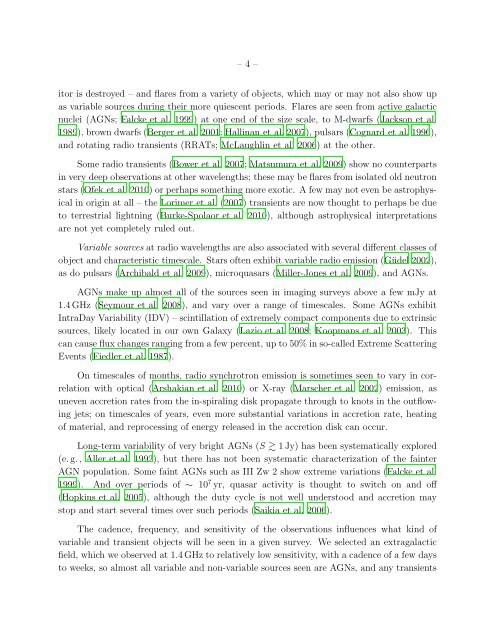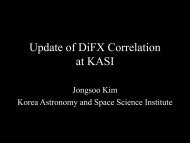The Allen Telescope Array Twenty-centimeter Survey—A - CIRA
The Allen Telescope Array Twenty-centimeter Survey—A - CIRA
The Allen Telescope Array Twenty-centimeter Survey—A - CIRA
You also want an ePaper? Increase the reach of your titles
YUMPU automatically turns print PDFs into web optimized ePapers that Google loves.
– 4 –<br />
itor is destroyed – and flares from a variety of objects, which may or may not also show up<br />
as variable sources during their more quiescent periods. Flares are seen from active galactic<br />
nuclei (AGNs; Falcke et al. 1999) at one end of the size scale, to M-dwarfs (Jackson et al.<br />
1989), brown dwarfs (Berger et al. 2001; Hallinan et al. 2007), pulsars (Cognard et al. 1996),<br />
and rotating radio transients (RRATs; McLaughlin et al. 2006) at the other.<br />
Some radio transients (Bower et al. 2007; Matsumura et al. 2009) show no counterparts<br />
in very deep observations at other wavelengths; these may be flares from isolated old neutron<br />
stars (Ofek et al. 2010) or perhaps something moreexotic. A fewmay not even beastrophysical<br />
in origin at all – the Lorimer et al. (2007) transients are now thought to perhaps be due<br />
to terrestrial lightning (Burke-Spolaor et al. 2010), although astrophysical interpretations<br />
are not yet completely ruled out.<br />
Variable sources at radio wavelengths are also associated with several different classes of<br />
object and characteristic timescale. Stars often exhibit variable radio emission (Güdel 2002),<br />
as do pulsars (Archibald et al. 2009), microquasars (Miller-Jones et al. 2009), and AGNs.<br />
AGNs make up almost all of the sources seen in imaging surveys above a few mJy at<br />
1.4GHz (Seymour et al. 2008), and vary over a range of timescales. Some AGNs exhibit<br />
IntraDay Variability (IDV) – scintillation of extremely compact components due to extrinsic<br />
sources, likely located in our own Galaxy (Lazio et al. 2008; Koopmans et al. 2003). This<br />
cancause fluxchanges ranging fromafewpercent, upto50%inso-calledExtreme Scattering<br />
Events (Fiedler et al. 1987).<br />
On timescales of months, radio synchrotron emission is sometimes seen to vary in correlation<br />
with optical (Arshakian et al. 2010) or X-ray (Marscher et al. 2002) emission, as<br />
uneven accretion rates from the in-spiraling disk propagate through to knots in the outflowing<br />
jets; on timescales of years, even more substantial variations in accretion rate, heating<br />
of material, and reprocessing of energy released in the accretion disk can occur.<br />
Long-term variability of very bright AGNs (S 1Jy) has been systematically explored<br />
(e.g., Aller et al. 1992), but there has not been systematic characterization of the fainter<br />
AGN population. Some faint AGNs such as III Zw 2 show extreme variations (Falcke et al.<br />
1999). And over periods of ∼ 10 7 yr, quasar activity is thought to switch on and off<br />
(Hopkins et al. 2005), although the duty cycle is not well understood and accretion may<br />
stop and start several times over such periods (Saikia et al. 2006).<br />
<strong>The</strong> cadence, frequency, and sensitivity of the observations influences what kind of<br />
variable and transient objects will be seen in a given survey. We selected an extragalactic<br />
field, which we observed at 1.4GHz to relatively low sensitivity, with a cadence of a few days<br />
to weeks, so almost all variable and non-variable sources seen are AGNs, and any transients



